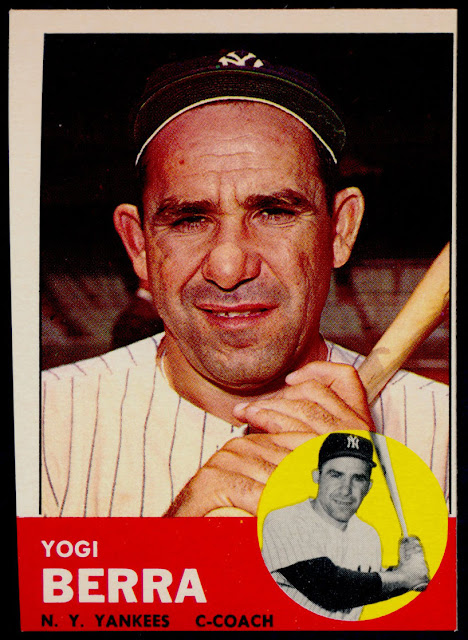Bit-by-bit, little details emerge about the production of the 1968 Topps 3-D Baseball set, which as intrepid readers here know, I consider to be one of the finest limited releases sets ever put out by the company. Prototypes, thought to be created specifically for Topps (more on that momentarily) were prepared by Visual Panographics of New York City, using a process they dubbed Xograph. You've probably seen a reference to both on the backs of the Kellogg's cards of the era.
It's those Kellogg's cards that muddy the waters a tad but everything I've ever seen in various auctions and writings of knowledgeable collectors indicates the 1968 3-D's and their various prototypes and proofs were prepared for Topps. So while things like this could theoretically fall into the category of "attributed to Topps" without more evidence, I think it's safe to call the prototypes and proofs Topps items.
The issued cards have their quirks but like many scarcer Topps products, were born in a retail test pack:
Which in turn came in a box that was likely plain, with a just a price sticker affixed.. A retail box was designed but in all probability never used:
Note the lack of a commodity code on the box bottom, which sometimes happened as sets and marketing were being developed. This lack of a code would also sometimes occur for items produced by a third party. The 3-D cards were designed to catch the eye and looked like this:
The Xograph logo is prominent in the lower left corner and the design would clearly be refined and form a template for the 1969 regular-issue Baseball cards. The reverse is blank, as this partial test pack content shows:
There would have been two cards within, plus the little easel seen at right, which is a scarce thing, and was gummed on the entire obverse:
It's long been theorized the cards were tested in Brooklyn before production was halted by Topps. Whether that stoppage was due to cost and/or issues with the materials used (some cards are found with "pull marks" visible), it seems any excess stock was bled off via a small coterie of hobby dealers, all with connections to Topps.
Pre-production items can be found but they are rare (and expensive):
It looks like autographs could have been considered as part of the design but it's not clear how that display was put together or by whom and the link to the item at
Heritage appears to be broken. You can see a Tommy Davis card in the middle of the right hand column. He's one of many proofs known in almost final form, although he never made the set:
Apologies for all the cribbed images, I only own two of these, one of which is a sample with a stamped back. You can clearly see two pull marks at the lower left of my Swoboda's obverse:
The back has a proprietary notice from Visual Panographics:
That style of ink-stamped back is also known in black:
It's not clear why two colors of back stamp exist. I've covered this before but will note again that a Futbol protype was created as well. It seems a little strange but Topps as a major international concern at this point:
This has a similar back stamp in the "Swoboda style":
(both images above courtesy Keith Olbermann)
The size of the Futbol card can't be ascertained but it seems smaller than the
Baseball prototypes based upon the cramped stamp. Another variant of back stamp in black has been seen though:
That back belongs to a Football front:
You can click over to see but two other Football pieces exist as well, one of which is another view of Starr and then this larger piece of Tucker Frederickson, described as being around the size of a 1974 Topps Baseball Puzzle:
Image sources vary, and it's possible none of them came from the Topps photo files.
Now take a look at that stamp on the back of the Starr prototype, it's also seen here as detailed in a old edition of The Standard Catalog of Baseball Cards:
I wonder if that means this style of stamp, with its larger all caps "title" line, indicates a true proof vs. a pre-production concept sample? Or perhaps it was a door opener made up by Visual Panographics.
Now, we get to the main reason for this post. What appears to be a fifth Brook Robinson card has popped up and was recently featured in a
Postwar Cards Newsletter, along with another very special American League player, one M. Clough:
OK it's obviously Yaz, as anyone can plainly see. Topps would sometimes do mockups and the like using weird or incorrect names so it's not surprising here. The reverse of the Yaz prototype gives us a pasted on version of the "Swoboda style" stamp:
Which all leads to our latest Brooks Robinson prototype:
Notice the large tear or crack running up from the bottom border into Robinson's jersey. I think four other versions of this card are out there (see
here for more on these):
1) Wavy
2) Clean (The SGC AUTHENTIC)
3) Dog Ear
4) Stamped Back (STANDARD CATALOG)
The reverse of this particular B. Robby shows signs of having the "Yaz style" pasted on stamp:
You can see the tear here as well, which is a great identifying mark. Hopefully additional protypes and samples will pop up and can provide more details about this endlessly fascinating set.








































